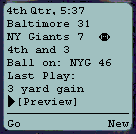The Sad State of the Mobile Web

I've written about this before, but I just happened to run across this list of mobile sites over at the Windows Mobile blog and I was pretty amazed to see how little progress the mobile web has made. I opened up all of the different sites listed to see what was up - it turns out it's a pretty sad state of affairs.
You can just see the history of the mobile web in those URLs actually. There are WML sites, text-only sites, sites for Avant-Go, sites for Palm Clipping, and sites for Pocket PCs. Only a handful of the sites in that list or this one are actually WAP2 (XHTML-MP), if any. And for most of the sites that are formated in a version that my phone can read, I'm better off using Skweezer to view them rather than bothering with the site's mobile version as they're all pretty useless.
What's wrong with them? Well, first is the content: Most of it is truncated down to just snippets of information. Why? I click on my mobile web browser, I wait 30 real-world seconds for it to connect and grab information. Finally it's there and what do I see? One paragraph of a story which tells me only the bare-minimum of information, or worse, a page of links for me to choose from so I can wait *another* 30 real-world seconds to get to some info. Great. I wouldn't have pulled out my phone to read a mobile website unless I had 20 or 30 minutes on my hands (I'm getting an oil change or I'm on the bus, etc.). I'm bored. I'm trapped. Entertain me, don't frustrate me!
There there's the opposite of this where there's just too much data. Just taking your website's RSS feeds and slapping a "mobile" template on the page doesn't count. First, the formatting may not be right for mobiles. Most of the mobiles I've seen aren't super-picky about XML formatting (they learned their lesson from WML which would balk at lots of common mistakes) but the effort still needs to be there to close your tags, etc. Beyond that, the pages just may be too long. Motorola browsers are notorious for their arbitrary max page length of around 5k. Go over that and the phone throws up a "413" error like it was the server's fault that the browser sucks. (This is the same browser found on the V series and the RAZR phones). And finally, the images just may be too big. I regularly pop 600x400 pixel photos weighing 30k on this site, but that doesn't mean that this is a good thing for the mobile version. These images need to be reduced substantially, both to fit on a small(er) screen and to reduce their total Kbs.
But there's more! The formatting of just about every website I saw is horrible. XHTML-MP phones can support all the basic formatting you need for a decent web page: alignment, font size, colors, tables, and standard images like gifs, jpegs and pngs and they support a basic version of style sheets called WAP-CSS. Every phone and browser renders differently, trust me, but hey, focus on the top 20% of the popular web browsers out there (which you would assume count for 80% of the web access) and you'll be doing pretty good. There's so much more that can be done for the mobile web.
The one standout site I found was ESPN Mobile. You can definitely look to them for inspiration. There's light graphics, yet compelling design. Use of tables for the scores and other information, and stories that are long and readable. All in XHTML-Basic. Nice. They even swap out the graphic depending on the device (my phone sees a different header than my browser). The table doesn't work perfectly, but at least they're trying... (I assume they're gearing up for their MVNO).
Still, it's amazing to me that with the billions of web pages out there that there are so few versions of sites that are made to be viewed by mobile phones. There's probably lots of pages I'm not seeing that are walled off - for example, I can't show you any of the operators websites since they're all on their local networks (like an intranet) blocking outside access. But still, there's all these public websites where the owners have done so little to support mobility. Companies need to *forget* their experiences with WAP 1.0 in the early part of the decade and realize five years have passed and the public is now ready for the mobile web.
It's not a chicken and egg thing any more. There are more XHTML-MP phones out there than all the PDAs combined. It's a fact: 50% of the people who own phones in the U.S. (that's 85 million people) bought them within the last 18 months. And since every operator since Christmas 2003 has sold XHTML phones, this means there are at *least* that many WAP2 phones here in the U.S. ready to see mobile content.
My prediction is that I can't be the only person to be noticing this vacuum, so watch out: I'd say within the next 18 months, the mobile web is going to become the next big thing.
-Russ